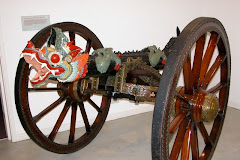After the major changes that took place in artillery at the end of the 19th Century - improvements in ammunition effectiveness, in range and accuracy, in survey, in communications and in the relatively new art of indirect fire - gunners began to use the new capabilities to concentrate fire.
In essence, this meant bringing down artillery fire on a target from more than a single battery. Now that they had the communications to pass target details to other batteries, it became possible to engage a target with every battery in range. The more that ranges improved, the more batteries it became possible to concentrate on a given target.
This in turn drove the pressure for further improvements in communications, with telephone lines and radio frequencies dedicated to artillery use, and procedures for command and control that established the priorities to be followed in engaging targets.
Survey methods were developed that put all batteries on the same 'grid' - i.e. knowing exactly where each one was in relation to all the others - and ensuring that they had a common 'orientation', so that when their sights were pointing at 'grid north', for example, all guns were parallel. When this was achieved, it became possible for one battery to be adjusted onto a target and any adjustments to the 'map bearing and range' by the 'ranging battery' could be applied to the map bearing and range of any other battery.This meant in effect that any other battery within range could engage the target without further adjustment. This not only saved time and ammunition, but provided no warning to the target about how many guns were about to engage it.
I have simplified the process to its essentials: it was in practice rather more complicated, but it was a major factor in World War 1, the first 'artillery war'. The stalemate of the trenches made attacking across the no man's land between them a deadly lottery. Artillery was needed to suppress enemy firepower whilst infantry crossed in the open to come to grips with their opposition. Complex fire plans were evolved, tasking batteries to engage targets in preparation for an attack, sometimes for days at a time, pounding at defences in an attempt to weaken strongpoints, cut barbed wire and crush morale. This preliminary bombardment would be followed by firing at specific targets at set times to coincide with infantry movement, aiming to keep the enemy's infantry hiding under cover while the attack developed across open ground. Batteries would then 'lift' to engage targets in rear of the front lines, aiming to break up counter-attacks and to suppress enemy batteries.
One of the new methods of fire involved 'creeping barrages', with the supporting fire falling in lines just in front of the advancing troops and lifting line by line as little as 50 yards ahead of the infantry. These barrages were immensely complicated to work out and to achieve, but they were nonetheless a useful aid in keeping the infantry moving in the right direction in the fog of war and in preventing the enemy machine-gunners from mowing down the unprotected infantry.
By the time of World War 2, the Allied firepower was so great that they could afford to hit anything that moved with devastating effect. This led to rapid advances in the closing year of the War as the German armies were forced back across north west Europe. The lesson was rammed home again in the first Gulf War: concentrated artillery firepower remains the Queen of the Battlefield.
Subscribe to:
Post Comments (Atom)




No comments:
Post a Comment